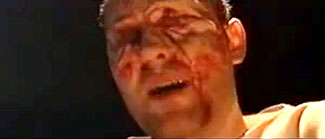 It seems as though "Pickman's Model" is one of the more commonly filmed Lovecraft stories for amateur movie makers.
It seems as though "Pickman's Model" is one of the more commonly filmed Lovecraft stories for amateur movie makers.
The sampling on The H. P. Lovecraft Collection Volume 4: Pickman's Model (2007) were by no means the whole of it, so let's look at some of those missing from the compilation.
Just under nine minutes in length, filmed widescreen in Spain, Inspiracion (2001) is another adaptation of the famous tale. Bright lighting robs it of atmosphere, but the videography is otherwise decently done, & the acting not laughable.
As the copy I saw at youtube lacked subtitles, I wasn't sure what Mike (Edu Blasco) was speaking about with a psychiatric caretaker (Elena Garcia), but in general the familiar tale needs no translation.
Mike has come to visit his friend Samuel (Gerapo Gallego) who has recently become an inmate of the insane asylum. He's alarmed to find not only that Samuel is in a straitjacket, but his self-mutilated eyes have been scratched blind. He's in a state of anger & fear & needs heavy sedation.
Attempting to find out what happened to his friend, Mike investigates the residence of a missing artist, Pickman, with whom Mike was last seen. Inspecting narrow passages evidently within the walls of the residence, he finds some of Pickman's horrific art (which, alas, looks like terribly sub-average comic book art).
Gazing at this cartoony art induces nightmarish visions & feelings. Then something we don't see grabs him. That's it. Film over.
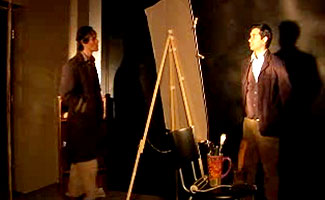 A version of Lovecraft's famous tale at a scant three minutes is likewise titled Pickman's Model (2007) written & directed by Alex Capriole while at the Tisch School of the Arts, New York University, using a digital camera.
A version of Lovecraft's famous tale at a scant three minutes is likewise titled Pickman's Model (2007) written & directed by Alex Capriole while at the Tisch School of the Arts, New York University, using a digital camera.
It stars fellow students Simon Millar as the infamous artist & Rit Saraswat as his friend Thurber.
It's not too badly staged, with nicely shadowed lighting (in an amateur sort of way). The acting leaves less to be desired. Millar as Pickman comes off as a theater-fag or very childish brat, not a morbid artist. He is griping about the art establishment failing to realize what a genius he is, sounding like a bitterly talentless dork.
He unveils his photo-realistic painting of a demon for Thurber. We never get to see it, but Thurber is startled, then acknowledges the painting as a work of genius. Many a filmed version of this tale falls flat on its face because it'll show artwork that is laughably bad. This version gets around it by showing only the back of the canvas.
Pickman pounds on the wall, gripes about "rats!" & complains that the landlord's a dago. He then exits the room & Thurber's alone with the painting. He looks at a photograph & realizes it's an actual snapshot of the original of Pickman's subject. Again we don't see that.
Pickman returns to the room & his theater-fag demeanor makes it seem like he's disappointed Thurber wants to leave in a hurry instead of sticking around to pork one another. Bad film, but so short it doesn't overstay its welcome.
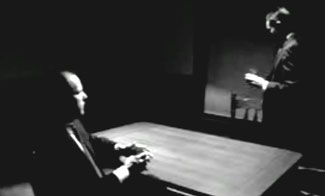 About six & a half minutes, filmed in black & white -- & mostly alas in black, the videography being far too dark -- another little Pickman's Model (2007) was directed by Matt Vrtiska.
About six & a half minutes, filmed in black & white -- & mostly alas in black, the videography being far too dark -- another little Pickman's Model (2007) was directed by Matt Vrtiska.
Vrtiska has worked behind the scenes on a couple commercial films besides helping fellow beginners on short subjects, yet he seems never personally to have learned even so little as how to light a set.
Thurber (Jack Carpenter) is being grilled by his friend Eliot (Matt Maude) about Pickman's disappearance & the fact that Thurber had removed all Pickman's work from his gallery. Reluctantly Thurber begins to tell the story of their last meeting.
In such serious tones it's unintentionally comical, he tells of the painting "The Lesson" depicting wolves raising a human child, teaching it to eat as do they, which even his friend doesn't think sounds all that bad. Eliot tries to convey his feeling about the "hell fires" awakened by a viewing of this & other horrific paintings in Eliot's basement studio.
The camera moves about the table a bit, but staging & editing is minimal, just two men at a table, acting out the story as a playlette. Thurber just tells the tale of Pickman's art, the pay-off being his assertion that there was a photo of the impossible model tacked to one of the canvasses. "It was simply the monstrous being he was painting on that awful canvas. By god Eliot, it was a photograph -- from life!"
Lovecraft could pull off stuff like that with the excesses of prose & reliance on reader imagination. Cinema is often too damned literal for it to work, especially with amateur players to overdo the melodrama. And I'm afraid the script reduces a wonderful story to such a rudiimentary wirework that the plot is trivialized, or rendered cornpone.
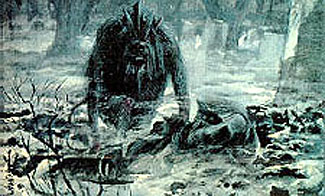 Two tales & a vignette make up a trilogy of tales for the second-season thirty-second episode of Night Gallery: Pickman's Model, The Dear Departed, An Act of Chivalry (1971).
Two tales & a vignette make up a trilogy of tales for the second-season thirty-second episode of Night Gallery: Pickman's Model, The Dear Departed, An Act of Chivalry (1971).
In the first & by far the best of the three, Bradford Dillman is Richard Upton Pickman, morbid artist who "recruits his models from odd places," as Rod Serling describes it in his wee introduction.
At considerable variance to Lovecraft's original, in this version Elliot (Joshua Bryant) is a modern day gent who has rented a well-lit loft, in which he discovers a macabre painting hidden in a nook, entitled "Ghoul Preparing to Die."
It transpires that the loft had been Pickman's art studio before he vanished seventy-five years earlier. In somewhat clumsy flashback, we are filled in on Pickman's last days. We first see him teaching an art class to a group of upperclass women. Mavis Goldsmith (Louise Sorel) has a crush upon the instructor, & her character is a stand-in for Thurber of Lovecraft's tale.
He's soon fired because he was hired to teach idle women to do innocuous still lives. The Institute disdains his demonic paintings as a bad influence on women of senstive birth. Mavis to keep her connection to Pickman pursues him into his own low neighborhood, invading even the privacy of his involate studio.
He tells her of "an eldritch race" of wretched mutations "surfacing in the dead of night & returning before dawn to practice their unspeakable acts," awaiting the day when their numbers are sufficient to rise up & conquer humanity. It is this race he is driven to paint.
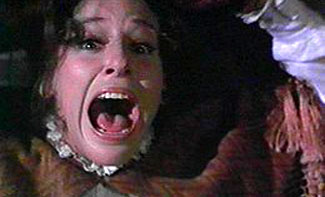 There are intimations that Pickman's mother had been kidnapped by one of the half-humans when he was a boy, & his model just might be family. There are intimations that Pickman's mother had been kidnapped by one of the half-humans when he was a boy, & his model just might be family.
Further, as he wears gloves to disguise his own mutant hands, he may be a direct relation to those beasts, which would account for his ability to use them as models rather than just be eaten.
Mavis arrives uninvited to his residence & loft, finding it dark & rat-infested. When Richard catches her rooting about through his art, he begs her to leave, & to do so quickly. But then, at a sound, he says, "Oh my god, it's too late," & closes her in the room telling her not to come out no matter what she hears.
All too soon the beast -- quite a decent costume -- enters the room & chases the screaming woman about, lifts her up with obvious intent of taking her into the tunnels for mating purposes.
The subtlty of Lovecraft's method of indirect revelation is transformed to outright creature-tale, with monster menacing the beauty, & Pickman sacrificing himself to rescue her.
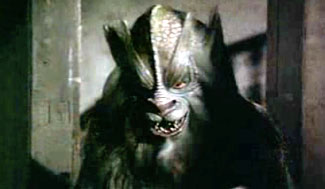 It's scarsely Lovecraft's tale any longer, but it's very well done for a tv show, & one of the better Night Gallery pieces, whether or not that's saying much. It's scarsely Lovecraft's tale any longer, but it's very well done for a tv show, & one of the better Night Gallery pieces, whether or not that's saying much.
In the coda, back in modern times, Elliot & a gallery owner search the residence for additional art, discovering in the basement a sealed well. The tale ends with the creature waiting to be let out.
The second tale regards an unexpectedly successful sceance, based on a short story by Alice-Mary Schnirring, "The Dear Departed," which first appeared in Weird Tales (May 1944). It's minor.
The third tale "An Act of Chivalry" is merely a joke vignette written by director Jack Laird, so lame I can't bring myself to retell it. So really only "Pickman's Model" matters, & Night Gallery might've been a more successful series overall if they didn't invariably water down a well-done story with additional pieces that get dumb & dumber.
For more H. P. Lovecraft micromovies, continue to:
Ryleh (2003) & A Lovecraft Dream (2008)
copyright © by Paghat the Ratgirl
|
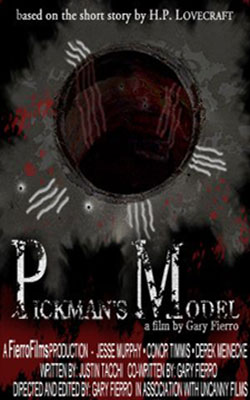
 It seems as though "Pickman's Model" is one of the more commonly filmed Lovecraft stories for amateur movie makers.
It seems as though "Pickman's Model" is one of the more commonly filmed Lovecraft stories for amateur movie makers.
 About six & a half minutes, filmed in black & white -- & mostly alas in black, the videography being far too dark -- another little Pickman's Model (2007) was directed by Matt Vrtiska.
About six & a half minutes, filmed in black & white -- & mostly alas in black, the videography being far too dark -- another little Pickman's Model (2007) was directed by Matt Vrtiska. Two tales & a vignette make up a trilogy of tales for the second-season thirty-second episode of Night Gallery: Pickman's Model, The Dear Departed, An Act of Chivalry (1971).
Two tales & a vignette make up a trilogy of tales for the second-season thirty-second episode of Night Gallery: Pickman's Model, The Dear Departed, An Act of Chivalry (1971). There are intimations that Pickman's mother had been kidnapped by one of the half-humans when he was a boy, & his model just might be family.
There are intimations that Pickman's mother had been kidnapped by one of the half-humans when he was a boy, & his model just might be family. It's scarsely Lovecraft's tale any longer, but it's very well done for a tv show, & one of the better Night Gallery pieces, whether or not that's saying much.
It's scarsely Lovecraft's tale any longer, but it's very well done for a tv show, & one of the better Night Gallery pieces, whether or not that's saying much.